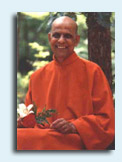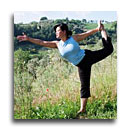 Kripalu Yoga is a modern school of Yoga that reflects a
synthesis of traditional approaches. It is based on the teachings of
Swami
Kripalvanandji. For a history of
Kripalu click here.
Kripalu Yoga incorporates into one
system the physical and purification practices of Hatha Yoga; the mental
disciplines of Raja Yoga; the prana awakening principles of Kundalini
Yoga; the devotion of Bhakti Yoga; and the emphasis on service of Karma
Yoga. Kripalu Yoga is a modern school of Yoga that reflects a
synthesis of traditional approaches. It is based on the teachings of
Swami
Kripalvanandji. For a history of
Kripalu click here.
Kripalu Yoga incorporates into one
system the physical and purification practices of Hatha Yoga; the mental
disciplines of Raja Yoga; the prana awakening principles of Kundalini
Yoga; the devotion of Bhakti Yoga; and the emphasis on service of Karma
Yoga.
More than a spiritual practice on the
Yoga mat, Kripalu Yoga is a holistic lifestyle in which the principles of
Yoga are applied off the mat in daily life. The key to the practice of
Kripalu Yoga lies in understanding prana (universal life-force) as a link between body, mind, and
spirit. The regular practice of Kripalu Yoga will result in the awakening
of prana, which allows the deeper aspects of Yoga
and meditation to manifest spontaneously and effortlessly.
Throughout Kripaluís three-stage
approach, you are guided to move at your own pace, honoring your
bodyís needs in each moment. Kripalu Yoga develops the body, mind and
spirit in a compassionate and non-judgmental way. You leave the class
feeling uplifted and centered.
Stage 1
Willful Practice (Body and Breath Awareness) begins with an
experiential approach to understanding the details of alignment and
the coordination of breath while moving into and out of postures.
Stage 2
Holding the Posture (Inner Focus and Concentration) guides you to
focus your attention on inner sensations, thoughts and emotions. You
learn to hold postures for longer periods of time while cultivating
compassion and awareness.
Stage 3
Meditation in Motion (Absorption) is a unique and personal expression
of Kripalu Yoga. You practice the art of moving in response to your
bodyís wisdom, with postures flowing from one into the next. This
experience is often described as a state of prayer expressed in
movement.
"Kripalu
is the first traditional yoga ashram founded on the guru-disciple
model to transition to a new paradigm of spiritual education. This
paradigm is designed to provide tools that help individuals access
their inner wisdom and find support for their ongoing process of
growth and spiritual development. Kripalu honors all traditional and
contemporary spiritual teachings that support the individual's
direct experience of Spirit." -Kripalu
|
Other types of yoga include:
Karma Yoga:
selfless service
Bhakti Yoga:
devotion to God, including chanting, and prayers
Raja Yoga:
meditation
Kundalini Yoga:
arousal of the psychospiritual energy
Jnana Yoga:
knowledge and wisdom through study and self-observation.
General
Structure of Class
1) Centering.
Taking the time to settle into your space and connect with the
breath. You may hear poetry or readings that create a theme for the
practice.
2) Warm-ups. Depending on the postures we will
practice in class, movements will help to warm muscles and
joints for more effective and safe movement.
3) Postures. Also known as asanas, these are poses that will
teach us alignment as well as strengthen and cleanse the body.
4) Cool Down. Stretches to further improve flexibility,
create space for more breath.
5) Deep Relaxation. Also known as yoga nidra or savasana (corpse
pose). A time to practice withdrawal of the senses by focusing on
the breath and releasing tension. Very important in closing our yoga
practice and transitioning to external activities.
|




 Kripalu Yoga is a modern school of Yoga that reflects a
synthesis of traditional approaches. It is based on the teachings of
Kripalu Yoga is a modern school of Yoga that reflects a
synthesis of traditional approaches. It is based on the teachings of